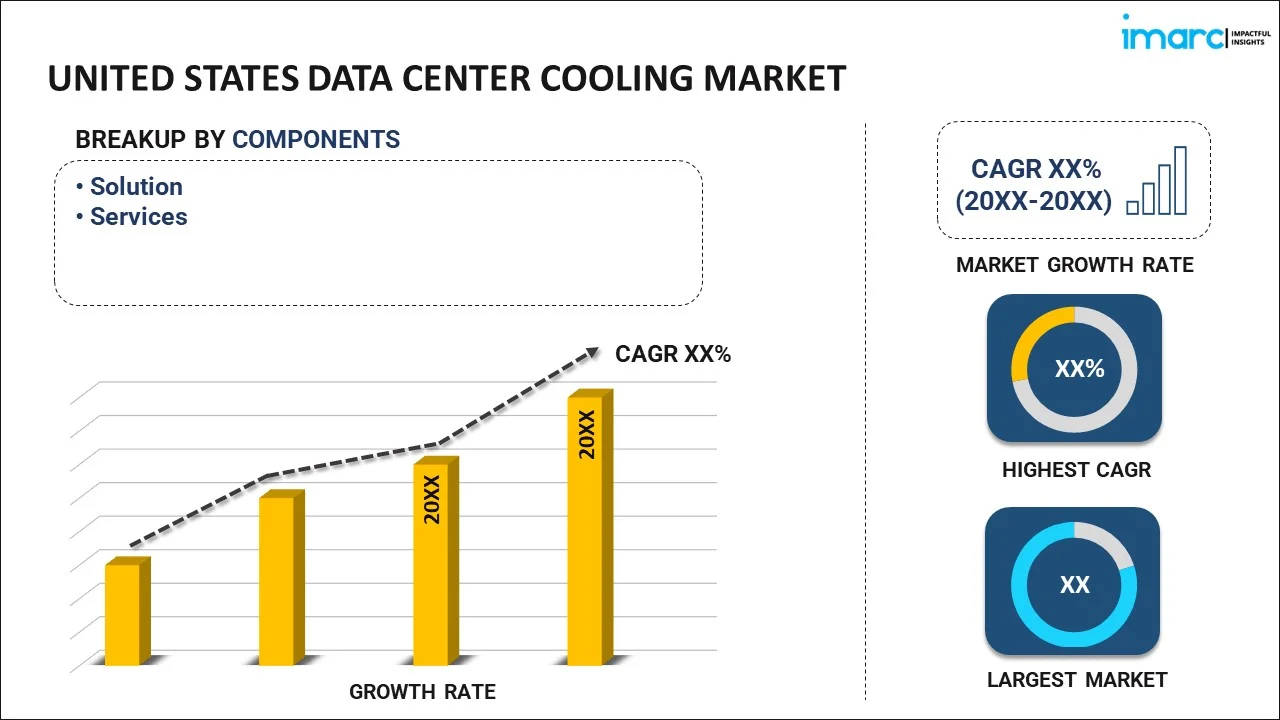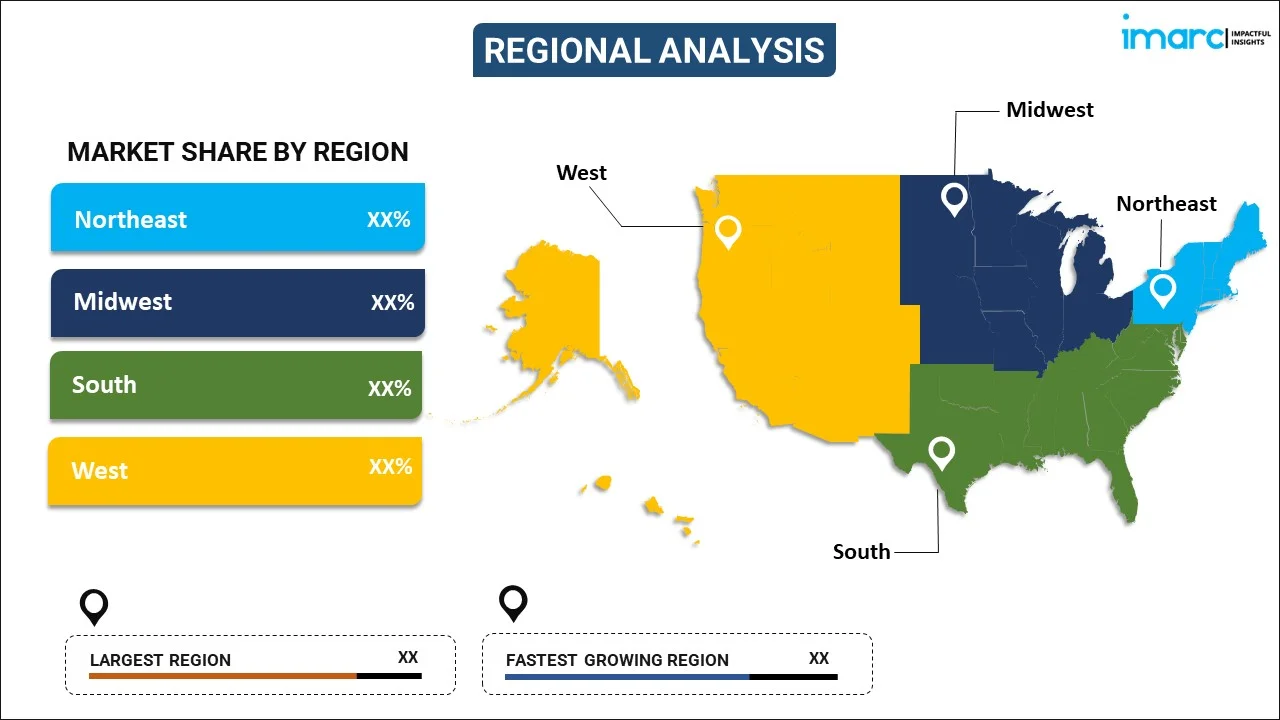
United States Data Center Cooling Market Report by Component (Solution, Services), Type of Cooling (Room-Based Cooling, Row-Based Cooling, Rack-Based Cooling), Cooling Technology (Liquid-Based Cooling, Air-Based Cooling), Type of Data Center (Mid-Sized Data Centers, Enterprise Data Centers, Large Data Centers), Vertical (BFSI, IT and Telecom, Research and Educational Institutes, Government and Defense, Retail, Energy, Healthcare, and Others), and Region 2025-2033
Market Overview:
United States data center cooling market size reached USD 5.1 Billion in 2024. Looking forward, IMARC Group expects the market to reach USD 16.3 Billion by 2033, exhibiting a growth rate (CAGR) of 12.70% during 2025-2033. The increasing data generation, cloud computing adoption, digital transformation trends, the proliferation of the Internet of Things (IoTs), growing environmental sustainability concerns, high-performance computing (HPC) applications, and regulatory compliance requirements represent some of the key factors driving the market.
|
Report Attribute
|
Key Statistics
|
|---|---|
|
Base Year
|
2024
|
|
Forecast Years
|
2025-2033
|
|
Historical Years
|
2019-2024
|
|
Market Size in 2024
|
USD 5.1 Billion |
|
Market Forecast in 2033
|
USD 16.3 Billion |
| Market Growth Rate 2025-2033 | 12.70% |
Data center cooling is a critical aspect of data center infrastructure management aimed at maintaining optimal operating temperatures within server rooms and data storage facilities. As data centers house a multitude of servers and electronic equipment, they generate substantial heat during regular operations. Effective cooling systems are employed to dissipate this heat and prevent overheating, which can lead to hardware malfunctions and operational disruptions. The primary goal of data center cooling is to create a controlled environment where temperatures, humidity, and airflow are carefully regulated to ensure the efficient functioning and longevity of the electronic components. Various cooling methods, such as air conditioning, liquid cooling, and specialized ventilation systems, are employed to address the diverse needs of modern data centers. The choice of cooling method depends on factors like the size of the data center, the density of the installed hardware, and energy efficiency considerations. Proper data center cooling helps safeguard equipment from thermal stress and contributes to energy efficiency, cost savings, and overall environmental sustainability of the digital infrastructure.
United States Data Center Cooling Market Trends:
The exponential rise in data generation and consumption in the United States, fueled by the proliferation of digital technologies creating a surging demand for data center infrastructure, is primarily driving the demand for efficient cooling solutions. Besides this, the escalating adoption of cloud computing services is amplifying the need for data centers as organizations migrate their operations to cloud-based platforms, bolstering the overall demand for cooling systems. Moreover, the ongoing trend of digital transformation across industries, prompting businesses to invest in advanced data center facilities, is acting as another significant growth-inducing factor. In confluence with this, the surge in Internet of Things (IoT) devices and connected technologies is contributing to an increase in data traffic, underscoring the significance of efficient cooling mechanisms to prevent system overheating. Concurrently, the rising concerns about environmental sustainability and energy efficiency urging data center operators to adopt innovative cooling technologies to reduce their carbon footprint are creating a favorable outlook for market expansion. In addition to this, the growing prevalence of high-performance computing (HPC) applications in fields, such as scientific research, artificial intelligence, and financial modeling is positively impacting the market growth, as these applications necessitate enhanced cooling capabilities. Furthermore, stringent regulatory requirements regarding data security and privacy are compelling organizations to invest in state-of-the-art data center infrastructure, including advanced cooling solutions, providing an impetus to the market growth. Apart from this, the global trend towards edge computing, which involves processing data closer to the source, is leading to the establishment of smaller data centers, each requiring efficient cooling to maintain optimal performance, thereby strengthening the market growth.
United States Data Center Cooling Market Segmentation:
IMARC Group provides an analysis of the key trends in each segment of the market, along with forecasts at the country level for 2025-2033. Our report has categorized the market based on component, type of cooling, cooling technology, type of data center, and vertical.
Component Insights:

- Solution
- Air Conditioning
- Chilling Units
- Cooling Towers
- Economizer Systems
- Liquid Cooling Systems
- Control Systems
- Others
- Services
- Consulting
- Installation and Deployment
- Maintenance and Support
The report has provided a detailed breakup and analysis of the market based on the component. This includes solution (air conditioning, chilling units, cooling towers, economizer systems, liquid cooling systems, control systems, and others) and services (consulting, installation and deployment, and maintenance and support).
Type of Cooling Insights:
- Room-Based Cooling
- Row-Based Cooling
- Rack-Based Cooling
A detailed breakup and analysis of the market based on the type of cooling have also been provided in the report. This includes room-based cooling, row-based cooling, and rack-based cooling.
Cooling Technology Insights:
- Liquid-Based Cooling
- Air-Based Cooling
The report has provided a detailed breakup and analysis of the market based on the cooling technology. This includes liquid-based cooling and air-based cooling.
Type of Data Center Insights:
- Mid-Sized Data Centers
- Enterprise Data Centers
- Large Data Centers
A detailed breakup and analysis of the market based on the type of data center have also been provided in the report. This includes mid-sized data centers, enterprise data centers, and large data centers.
Vertical Insights:
- BFSI
- IT and Telecom
- Research and Educational Institutes
- Government and Defense
- Retail
- Energy
- Healthcare
- Others
The report has provided a detailed breakup and analysis of the market based on vertical. This includes BFSI, IT and telecom, research and educational institutes, government and defense, retail, energy, healthcare, and others.
Regional Insights:

- Northeast
- Midwest
- South
- West
The report has also provided a comprehensive analysis of all the major regional markets, which include Northeast, Midwest, South, and West.
Competitive Landscape:
The market research report has also provided a comprehensive analysis of the competitive landscape. Competitive analysis such as market structure, key player positioning, top winning strategies, competitive dashboard, and company evaluation quadrant has been covered in the report. Also, detailed profiles of all major companies have been provided.
United States Data Center Cooling Market Report Coverage:
| Report Features | Details |
|---|---|
| Base Year of the Analysis | 2024 |
| Historical Period | 2019-2024 |
| Forecast Period | 2025-2033 |
| Units | Billion USD |
| Scope of the Report | Exploration of Historical and Forecast Trends, Industry Catalysts and Challenges, Segment-Wise Historical and Predictive Market Assessment:
|
| Components Covered |
|
| Types of Cooling Covered | Room-Based Cooling, Row-Based Cooling, Rack-Based Cooling |
| Cooling Technologies Covered | Liquid-Based Cooling, Air-Based Cooling |
| Types of Data Center Covered | Mid-Sized Data Centers, Enterprise Data Centers, Large Data Centers |
| Verticals Covered | BFSI, IT and Telecom, Research and Educational Institutes, Government and Defense, Retail, Energy, Healthcare, Others |
| Regions Covered | Northeast, Midwest, South, West |
| Customization Scope | 10% Free Customization |
| Post-Sale Analyst Support | 10-12 Weeks |
| Delivery Format | PDF and Excel through Email (We can also provide the editable version of the report in PPT/Word format on special request) |
Key Questions Answered in This Report:
- How has the United States data center cooling market performed so far and how will it perform in the coming years?
- What has been the impact of COVID-19 on the United States data center cooling market?
- What is the breakup of the United States data center cooling market on the basis of component?
- What is the breakup of the United States data center cooling market on the basis of type of cooling?
- What is the breakup of the United States data center cooling market on the basis of cooling technology?
- What is the breakup of the United States data center cooling market on the basis of type of data center?
- What is the breakup of the United States data center cooling market on the basis of vertical?
- What are the various stages in the value chain of the United States data center cooling market?
- What are the key driving factors and challenges in the United States data center cooling?
- What is the structure of the United States data center cooling market and who are the key players?
- What is the degree of competition in the United States data center cooling market?
Key Benefits for Stakeholders:
- IMARC’s industry report offers a comprehensive quantitative analysis of various market segments, historical and current market trends, market forecasts, and dynamics of the United States data center cooling market from 2019-2033.
- The research report provides the latest information on the market drivers, challenges, and opportunities in the United States data center cooling market.
- Porter's five forces analysis assist stakeholders in assessing the impact of new entrants, competitive rivalry, supplier power, buyer power, and the threat of substitution. It helps stakeholders to analyze the level of competition within the United States data center cooling industry and its attractiveness.
- Competitive landscape allows stakeholders to understand their competitive environment and provides an insight into the current positions of key players in the market.
Need more help?
- Speak to our experienced analysts for insights on the current market scenarios.
- Include additional segments and countries to customize the report as per your requirement.
- Gain an unparalleled competitive advantage in your domain by understanding how to utilize the report and positively impacting your operations and revenue.
- For further assistance, please connect with our analysts.

 Inquire Before Buying
Inquire Before Buying
 Speak to an Analyst
Speak to an Analyst
 Request Brochure
Request Brochure
 Request Customization
Request Customization



.webp)




.webp)












